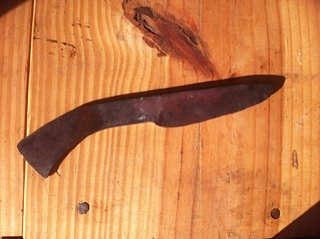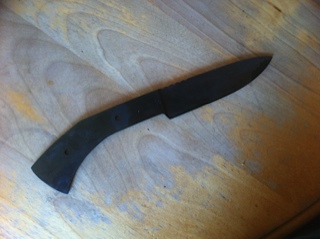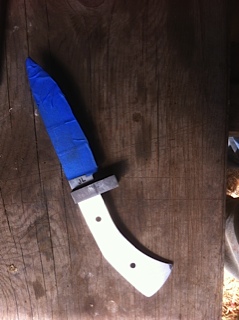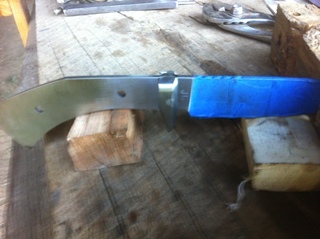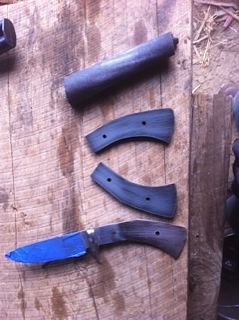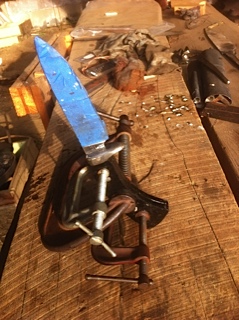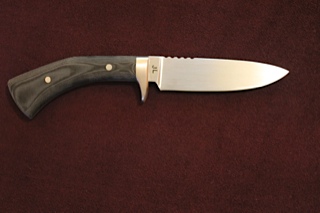This 4.5†was made for a local veterinarian. The blade is 440C stainless steel, the guard and pins are 416 stainless steel, and the handle is black linen micarta. I chose these materials because of their ability to withstand corrosive sanitizing chemicals, such as those used on veterinary equipment.
I forged the knife using wood as my fuel source. I found that, when forging stainless, it is critical to keep it within the lower forging temperatures, as too much heat can lead to the steel cracking. I also found that 440C is less prone to cracking when forged with more blows of a lighter hammer, rather than fewer blows with a heavy one.
Here is the blade after forging:
I then ground the blade, drilled holes for the handle pins, filed the plunge cuts, filed the thumb stop, and stamped it with my initials. (no pictures for these stages, sorry)
After rough grinding, I wrapped the blade in stainless steel foil, heated it to 1850ºF in my heat treating oven and held for 30 minutes. I hardened it using an interrupted oil quench. After the quench, I unwrapped the blade, tested for hardness, and tempered it twice in the oven at 425ºF. Here is the blade after heat treat.
The heat treating of this knife was the source of a bit of frustration for me. On my first try, the blade did not harden, which I think was due to decarburization in the oven without a foil wrap. When I forged the blade again and austentized with the foil wrap, the blade hardened satisfactorily.
After tempering, I ground the blade to 400 grit, and carefully hand sanded to 400 grit. I then taped the blade with masking tape to protect the finish through the handle and guard fitting.
To make the guard, I started with a 1 1/2†length of 416 stainless barstock, 3/4†by 3/8â€. I cut a slot in the guard to admit the tang, using first an angle grinder with a cutoff wheel and then several flat files to fit the slot exactly to the tang.
Here is the knife, with the blade taped and the guard slotted:
After fitting the guard blank to the blade, I drilled through the guard and blade, and tapered the holes in the guard using a homemade tapering tool.
I then shaped the guard on my belt grinder and hand sanded it to 400 grit. I epoxied the guard onto the handle, and riveted the two together, using 1/8†416 stainless rod as my rivet stock.
To make the handle, I traced the full tang of the knife onto 1/4†thick micarta, and cut out two handle scales using a jigsaw. I then drilled through the handle scales and attached them to the tang using epoxy and 3/16†416 stainless pins.
The handle scales roughened with 50 grit paper for the epoxy to hold.
The epoxy drying.
After the epoxy hardened, I shaped the handle on my belt grinder, and finished it with 400 grit sandpaper.

